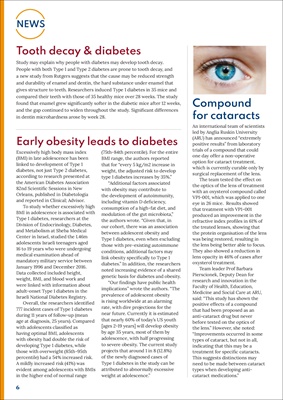
6
NEWS
Tooth decay & diabetes
Study may explain why people with diabetes may develop tooth decay.
People with both Type 1 and Type 2 diabetes are prone to tooth decay, and
a new study from Rutgers suggests that the cause may be reduced strength
and durability of enamel and dentin, the hard substance under enamel that
gives structure to teeth. Researchers induced Type 1 diabetes in 35 mice and
compared their teeth with those of 35 healthy mice over 28 weeks. The study
found that enamel grew significantly softer in the diabetic mice after 12 weeks,
and the gap continued to widen throughout the study. Significant differences
in dentin microhardness arose by week 28.
Compound
for cataracts
An international team of scientists
led by Anglia Ruskin University
(ARU) has announced "extremely
positive results" from laboratory
trials of a compound that could
one day offer a non-operative
option for cataract treatment,
which is currently curable only by
surgical replacement of the lens.
The team tested the effect on
the optics of the lens of treatment
with an oxysterol compound called
VP1-001, which was applied to one
eye in 26 mice. Results showed
that treatment with VP1-001
produced an improvement in the
refractive index profiles in 61% of
the treated lenses, showing that
the protein organisation of the lens
was being restored, resulting in
the lens being better able to focus.
They also showed a reduction in
lens opacity in 46% of cases after
oxysterol treatment.
Team leader Prof Barbara
Pierscionek, Deputy Dean for
research and innovation in the
Faculty of Health, Education,
Medicine and Social Care at ARU,
said: "This study has shown the
positive effects of a compound
that had been proposed as an
anti-cataract drug but never
before tested on the optics of
the lens." However, she noted:
"Improvements occurred in some
types of cataract, but not in all,
indicating that this may be a
treatment for specific cataracts.
This suggests distinctions may
need to be made between cataract
types when developing anticataract
medications."
Early obesity leads to diabetes
Excessively high body mass index
(BMI) in late adolescence has been
linked to development of Type 1
diabetes, not just Type 2 diabetes,
according to research presented at
the American Diabetes Association
82nd Scientific Sessions in New
Orleans, published in Diabetologia
and reported in Clinical; Advisor.
To study whether excessively high
BMI in adolescence is associated with
Type 1 diabetes, researchers at the
Division of Endocrinology, Diabetes,
and Metabolism at Sheba Medical
Center in Israel, studied the 1.46m
adolescents Israeli teenagers aged
16 to 19 years who were undergoing
medical examination ahead of
mandatory military service between
January 1996 and December 2016.
Data collected included height,
weight, BMI, and blood work and
were linked with information about
adult-onset Type 1 diabetes in the
Israeli National Diabetes Registry.
Overall, the researchers identified
777 incident cases of Type 1 diabetes
during 11 years of follow-up (mean
age at diagnosis, 25 years). Compared
with adolescents classified as
having optimal BMI, adolescents
with obesity had double the risk of
developing Type 1 diabetes, while
those with overweight (85th-95th
percentile) had a 54% increased risk.
A mildly increased risk (41%) was
evident among adolescents with BMIs
in the higher end of normal range
(75th-84th percentile). For the entire
BMI range, the authors reported
that for "every 5 kg/m2 increase in
weight, the adjusted risk to develop
type 1 diabetes increases by 35%."
"Additional factors associated
with obesity may contribute to
the development of autoimmunity,
including vitamin D deficiency,
consumption of a high-fat diet, and
modulation of the gut microbiota,"
the authors wrote. "Given that, in
our cohort, there was an association
between adolescent obesity and
Type 1 diabetes, even when excluding
those with pre-existing autoimmune
conditions, additional factors may
link obesity specifically to Type 1
diabetes." In addition, the researchers
noted increasing evidence of a shared
genetic basis for diabetes and obesity.
"Our findings have public health
implications" wrote the authors. "The
prevalence of adolescent obesity
is rising worldwide at an alarming
rate, with dire projections for the
near future. Currently it is estimated
that nearly 60% of today's US youth
[ages 2-19 years] will develop obesity
by age 35 years, most of them by
adolescence, with half progressing
to severe obesity. The current study
projects that around 1 in 8 (12.8%)
of the newly diagnosed cases of
Type 1 diabetes in the study can be
attributed to abnormally excessive
weight at adolescence."